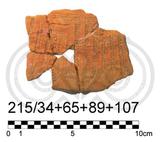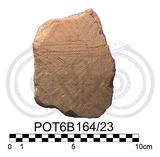TELDAP Collections
| The Prehistoric Pottery of Lapita Culture in the Pacific |
|
A drawing of Lapita pottery with intricate geometric patterns of anthropomorphic faces, unearthed at a site on the Solomon Islands The Lapita Cultural Complex, according to archaeological evidence, appeared on various islands scattered over a large expanse of sea, extending westward to the Bismarck Archipelago in Papua New Guinea, the Solomon Islands, the Vanuatu Islands and New Caledonia, and eastward to Fiji, Tonga and Samoa. The Lapita Cultural Complex was dated as far back as 3,600 to 2,500 years ago. Pottery decorated with fine dentate stamps is a major part of the Lapita Cultural Complex, which also includes stone tools, shell artifacts, and objects of barter. From the archaeological finding, one can infer that the subsistence economies of these islands were most likely based on marine resources, and the life style was very likely related to agriculture. Most of the Lapita pottery was made of clay found on local sites, tempered with calcium-containing substances such as sand or crushed shells, and kneaded into a clay mold. This mold, coated with additional pieces of clay, was then beaten into a shape with sticks and cobbles. While the clay was half dry, fine dentate stamps, incised patterns, or custom impressions were imprinted onto or patterns were added onto the surface of the pottery. Finally, the whole piece of pottery was fired at low outdoor temperature. Though extant archaeological data indicates over ten thousand years of human habitation in the Bismarck Archipelago and the northern part of the Solomon Islands, no evidence of pottery dating back to more than 3,500 years ago has been found. Given that the Lapita pottery closely resembles the pottery of Southeast Asia from the same period, archaeologists working in the Pacific generally thought that pottery was likely to be introduced into the Lapita area by the Austronesian peoples from the islands of Southeast Asia, who had established a long tradition of pottery production. However, the earliest Lapita pottery was decorated with highly elaborate patterns of anthropomorphic faces with few practical purposes, which not only were unknown to the inhabitants of the islands in Southeast Asia but also differed greatly from the popular patterns found in the Southeast Asian pottery of the same period. Hence archaeologists regard the differences as a proof of cultural exchanges and integration between the different civilizations. For the next hundreds of years, the Lapita Cultural Complex spread out over several uninhabited islands, including the southern part of the Solomon Islands, the Vanuatu Islands, New Caledonia, Fiji, Tonga and the Samoa Islands. The cultural extension represents outward expansion of the Austronesian people and establishes the material culture tradition of the entire Oceania.
Items of the Collection: The Prehistoric Pottery of Lapita Culture in the Pacific
Number:RL2-215-34+65+89+107
|















